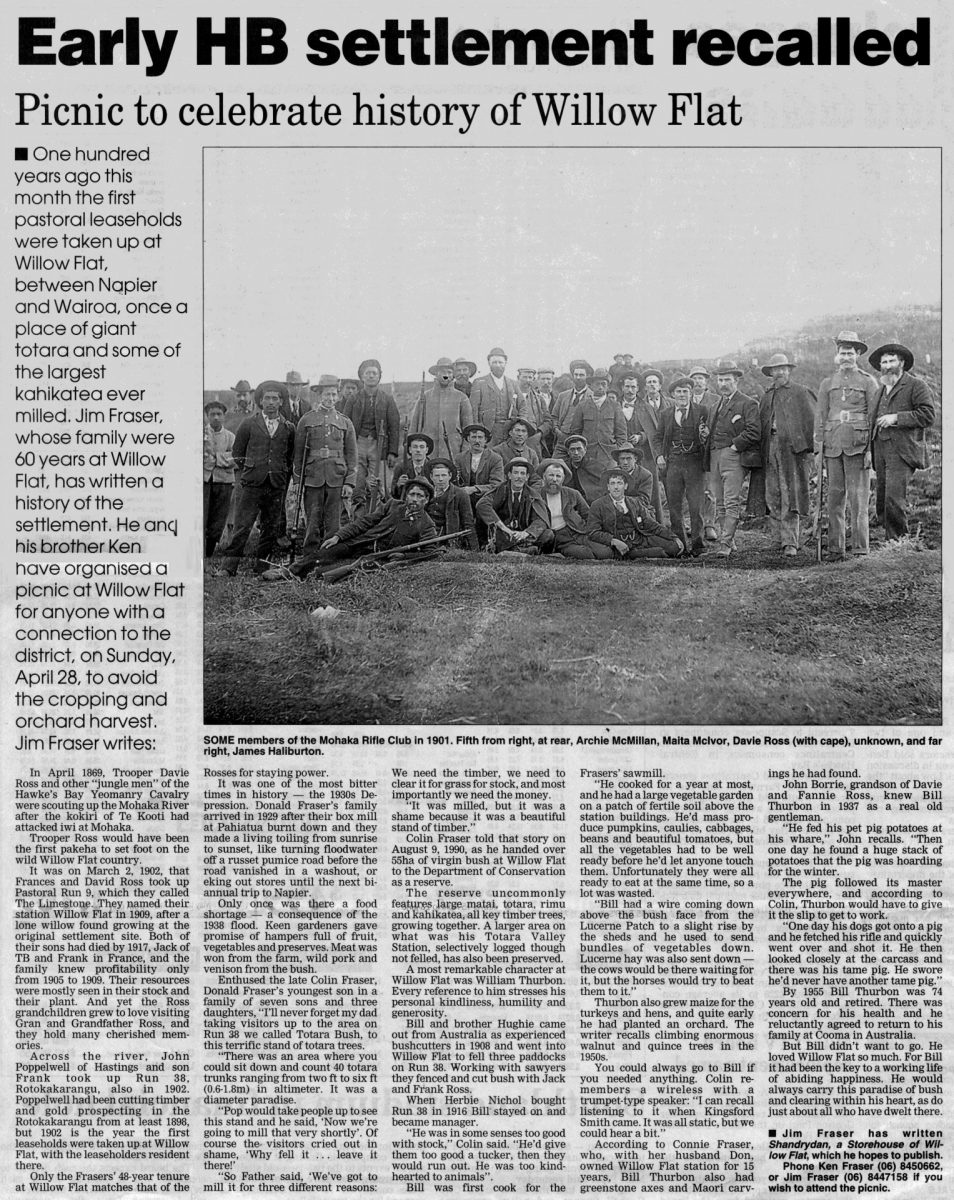Early HB settlement recalled
Picnic to celebrate history of Willow Flat
One hundred years ago this month the first pastoral leaseholds were taken up at Willow Flat, between Napier and Wairoa, once a place of giant totara and some of the largest kahikatea ever milled. Jim Fraser, whose family were 60 years at Willow Flat, has written a history of the settlement. He and his brother Ken have organised a picnic at Willow Flat for anyone with a connection to the district, on Sunday, April 28, to avoid the cropping and orchard harvest. Jim Fraser writes:
In April 1869, Trooper Davie Ross and other “jungle men” of the Hawke’s Bay Yeomanry Cavalry were scouting up the Mohaka River after the kokiri of Te Kooti had attacked iwi at Mohaka.
Trooper Ross would have been the first pakeha to set foot on the wild Willow Flat country.
It was on March 2, 1902, that Frances and David Ross took up Pastoral Run 9, which they called station Willow Flat in 1909, after a lone willow found growing at the original settlement site. Both of their sons had died by 1917, Jack of TB and Frank in France, and the family knew profitability only from 1905 to 1909. Their resources were mostly seen in their stock and their plant. And yet the Ross grandchildren grew to love visiting Gran and Grandfather Ross, and they hold many cherished memories.
Across the river, John Poppelwell of Hastings and son Frank took up Run 38, Rotokakarangu, also in 1902. Poppelwell had been cutting timber and gold prospecting in the Rotokakarangu from at least 1898, but 1902 is the year the first leaseholds were taken up at Willow Flat, with the leaseholders resident there.
Only the Frasers’ 48-year tenure at Willow Flat matches that of the Rosses for staying power.
It was one of the most bitter times in history – the 1930s Depression. Donald Fraser’s family arrived in 1929 after their box mill at Pahiatua burnt down and they made a living toiling from sunrise to sunset, like turning floodwater off a russet pumice road before the road vanished in a washout, or eking out stores until the next bi-annual trip to Napier.
Only once was there a food shortage – a consequence of the 1938 flood. Keen gardeners gave promise of hampers full of fruit, vegetables and preserves. Meat was won from the farm, wild pork and venison from the bush.
Enthused the late Colin Fraser, Donald Fraser’s youngest son in a family of seven sons and three daughters, “I’ll never forget my dad taking visitors up to the area on Run 38 we called Totara Bush, to this terrific stand of totara trees.
“There was an area where you could sit down and count 40 totara trunks ranging from two ft to six ft (0.6-1.8m) in altimeter. It was a diameter paradise.
“Pop would take people up to see this stand and he said, ‘Now we’re going to mill that very shortly’. Of course the visitors cried out in shame, ‘Why fell it leave it there!’
“So Father said, ‘We’ve got to mill it for three different reasons: We need the timber, we need to clear it for grass for stock, and most importantly we need the money.
“It was milled, but it was a shame because it was a beautiful stand of timber.”
Colin Fraser told that story on August 9, 1990, as he handed over 55ha of virgin bush at Willow Flat to the Department of Conservation as a reserve.
The reserve uncommonly features large matai, totara, rimu and kahikatea, all key timber trees, growing together. A larger area on what was his Totara Valley Station, selectively logged though not felled, has also been preserved.
A most remarkable character at Willow Flat was William Thurbon. Every reference to him stresses his personal kindliness, humility and generosity.
Bill and brother Hughie came out from Australia as experienced bushcutters in 1908 and went into Willow Flat to fell three paddocks on Run 38. Working with sawyers they fenced and cut bush with Jack and Frank Ross.
When Herbie Nichol bought Run 38 in 1916 Bill stayed on and became manager.
“He was in some senses too good with stock,” Colin said. ‘”He’d give them too good a tucker, then they would run out. He was too kind-hearted to animals”.
Bill was first cook for the Frasers’ sawmill.
“He cooked for a year at most, and he had a large vegetable garden on a patch of fertile soil above the station buildings. He’d mass produce pumpkins, caulies, cabbages, beans and beautiful tomatoes, but all the vegetables had to be well ready before he’d let anyone touch them. Unfortunately they were all ready to eat at the same time, so a lot was wasted.
“Bill had a wire coming down above the bush face from the Lucerne Patch to a slight rise by the sheds and he used to send bundles of vegetables down.
Lucerne hay was also sent down – the cows would be there waiting for it, but the horses would try to beat them to it.”
Thurbon also grew maize for the turkeys and hens, and quite early he had planted an orchard. The writer recalls climbing enormous walnut and quince trees in the 1950s.
You could always go to Bill if you needed anything. Colin remembers a wireless with a trumpet-type speaker: “I can recall listening to it when Kingsford Smith came. It was all static, but we could hear a bit.”
According to Connie Fraser, who, with her husband Don, owned Willow Flat station for 15 years, Bill Thurbon also had greenstone axes and Maori carvings he had found.
John Borrie, grandson of Davie and Fannie Ross, knew Bill Thurbon in 1937 as a real old gentleman.
“He fed his pet pig potatoes at his whare,” John recalls. “Then one day he found a huge stack of potatoes that the pig was hoarding for the winter.
The pig followed its master everywhere, and according to Colin, Thurbon would have to give it the slip to get to work.
“One day his dogs got onto a pig and he fetched his rifle and quickly went over and shot it. He then looked closely at the carcass and there was his tame pig. He swore he’d never have another tame pig.”
By 1955 Bill Thurbon was 74 years old and retired. There was concern for his health and he reluctantly agreed to return to his family at Cooma in Australia.
But Bill didn’t want to go. He loved Willow Flat so much. For Bill it had been the key to a working life of abiding happiness. He would always carry this paradise of bush and clearing within his heart, as do just about all who have dwelt there.
Jim Fraser has written Shandrydan, a Storehouse of Willow Flat, which he hopes to publish.
Phone Ken Fraser (06) 8450662, or Jim Fraser (06) 8447158 if you wish to attend the picnic.
Photo caption – SOME members of the Mohaka Rifle Club in 1901. Fifth from right, at rear, Archie McMillan, Maita McIvor, Davie Ross (with cape), unknown, and far right, James Haliburton.












Do you know something about this record?
Please note we cannot verify the accuracy of any information posted by the community.